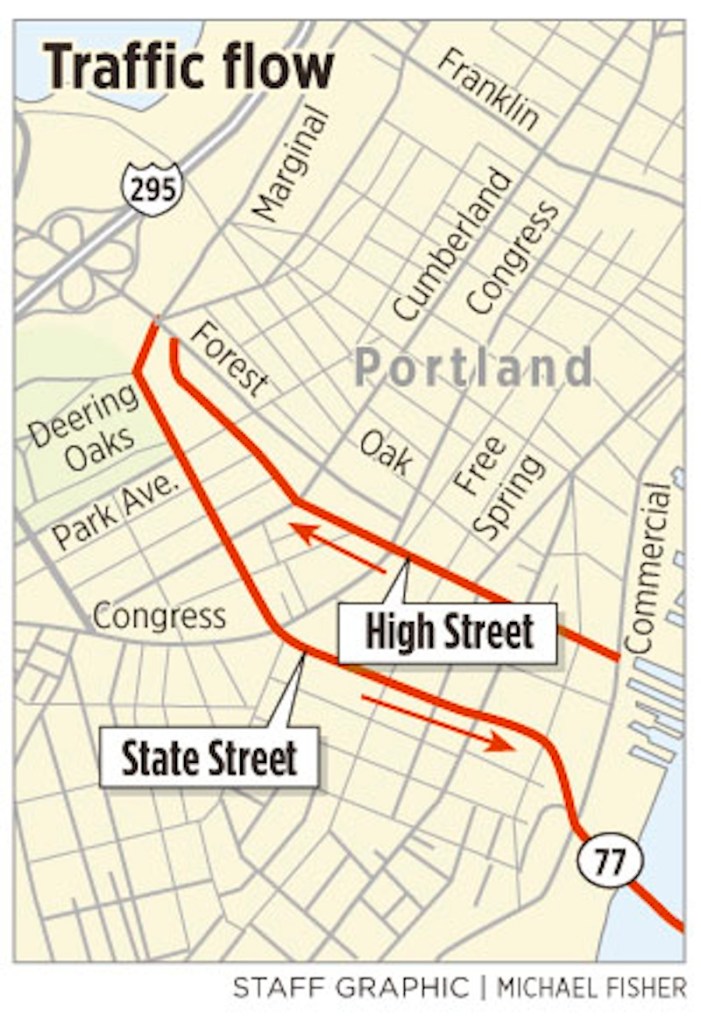PORTLAND — Converting State and High streets to two-way streets could work, a new feasibility study shows.
The results were presented Wednesday night to members of the City Council’s Transportation, Sustainability and Energy Committee.
Councilors who serve on the four-member panel directed Tom Errico, an engineer with T Y Lin International, to push forward with a more detailed engineering analysis.
Once that analysis is complete, the committee will consider the impact on traffic and surrounding neighborhoods before making a recommendation to the City Council.
Though the study raised a few concerns – such as whether there would be enough room for a city bus or large truck to turn from Congress onto High Street without colliding with traffic heading in the opposite direction – Errico said there was nothing dramatic enough to terminate the idea.
“In general, we found that converting the streets to two-way is not going to create gridlock,” Errico told the committee. “My sense is there doesn’t seem to be a fatal flaw.”
Last summer, the committee commissioned Errico to do a traffic study that would help them decide whether it would make sense to convert State and High streets from one-way to two-way streets.
Those streets cut through the city, connecting the Casco Bay Bridge with Interstate 295.
Residents lobbied for the change, arguing that two-way traffic would slow drivers down and make their streets safer.
High Street runs past the Portland Museum of Art and the Eastland Hotel before emptying onto Park and Forest avenues. State Street slices through Longfellow Square, past Mercy Hospital and 75 State Street, an assisted living facility.
Some residents told the committee that cars are going too fast, making it dangerous for pedestrians to cross.
“I’m one of the few people in this room who remembers when those streets were two-way,” said Marie Gray, who lives on State Street.
“Now it’s difficult to do a simple thing, like walk across the street.”
Errico said that converting one-way streets in other parts of the country has shown that the new configuration slows traffic.
High and State streets were two-way until the 1970s, when a study recommended turning them into two-lane, one-way roads.
The goal was to make it easier for drivers to get in and out of downtown Portland at a time when commerce was generally shifting to suburban malls.
Brian Peterson of Westbrook opposed the return to two-way streets.
He said making the streets two-way would not improve traffic in any way other than slowing cars down.
“They don’t want people driving through their neighborhood, but where does that leave the rest of the city?” Peterson asked.
Ellen Murphy, who serves on the board of directors for the Maine Irish Heritage Center on State Street, said the center often has to help residents of 75 State Street safely cross the road.
“High Street feels like a superhighway at times with people trying to beat the traffic light,” she said.
Councilor Kevin Donoghue said more study is needed to determine if bicyclists would be endangered by converting those streets to two-way.
“I’m generally encouraged by this, but I want to make sure we’re not making the streets less friendly for bikers,” Donoghue said.
Councilor David Marshall, who chairs the committee, said he found the information presented “promising.”
He also noted that the plan was getting support “from around the city.”
In addition to conducting an engineering analysis, city officials said they will begin to explore potential funding sources.
Staff Writer Dennis Hoey can be contacted at 791-6365 or at:
dhoey@pressherald.com
Copy the Story LinkSend questions/comments to the editors.




Success. Please wait for the page to reload. If the page does not reload within 5 seconds, please refresh the page.
Enter your email and password to access comments.
Hi, to comment on stories you must . This profile is in addition to your subscription and website login.
Already have a commenting profile? .
Invalid username/password.
Please check your email to confirm and complete your registration.
Only subscribers are eligible to post comments. Please subscribe or login first for digital access. Here’s why.
Use the form below to reset your password. When you've submitted your account email, we will send an email with a reset code.